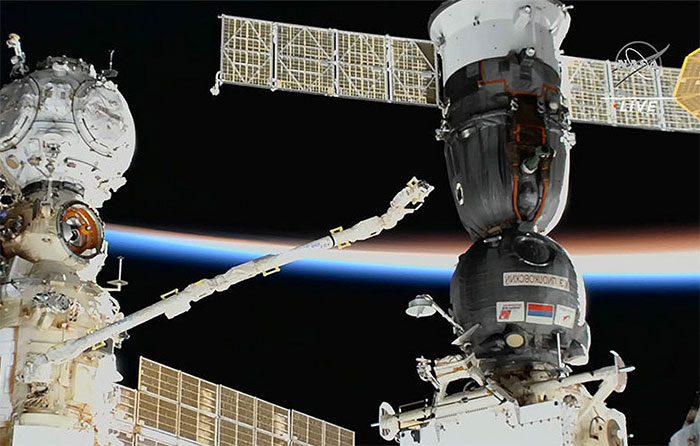The head of the Russian space agency (Roscosmos), Yury Borisov, announced on December 19 that a preliminary inspection of the Soyuz MS-22 spacecraft at the International Space Station (ISS) revealed a small hole in the equipment module.
The newspaper Izvestia quoted Yury Borisov as saying: “The preliminary inspection showed that there is a small hole about 0.8mm in size, causing a leak.” He described the situation as “not very pleasant,” but dismissed speculation that the temperature inside the spacecraft had risen above 50 degrees Celsius.

The Soyuz MS-22 spacecraft has a small leak in the equipment module.
Earlier, on December 15, a drop in pressure in the external cooling circuit of the manned Soyuz MS-22 spacecraft was recorded. A visual inspection of the spacecraft from the orbital outpost confirmed coolant leakage, leading to the cancellation of an upcoming spacewalk.
Roscosmos conducted a series of tests on the systems of the Soyuz MS-22 spacecraft, including testing its thrust control system, and found no other faults with the spacecraft.
According to TASS, Roscosmos reported that the internal temperature of the Soyuz MS-22 spacecraft had stabilized above 30 degrees Celsius.
“In the first few days following the leak, system checks showed temperatures rising above 30 degrees Celsius in the habitation module of the Soyuz MS-22 spacecraft and over 40 degrees Celsius in the equipment module. However, in recent days, with the spacecraft’s systems turned off, temperatures in the modules stabilized above 30 degrees Celsius,” stated Roscosmos.
The agency also mentioned that the increase in temperature inside the Soyuz MS-22 spacecraft was within acceptable limits and did not significantly affect the equipment or the health of the astronauts, should they be inside the spacecraft.
This leak caused coolant from the spacecraft to spill out into space, an event witnessed worldwide through videos released by NASA. Many expressed concerns for the safety of the astronauts aboard, which included two specialists from Russia and one from NASA.
Over the weekend, Tommaso Sgobba, President of the International Association for the Advancement of Space Safety (IAASS) and former Director of Space Flight Safety at ESA, was interviewed by Space, where he expressed his greatest concern that the Soyuz might not be able to return to Earth—a question to which Roscosmos has not yet provided an official answer.
If the spacecraft fails, the three astronauts could be stranded at the ISS for months before a rescue vehicle from Earth arrives and would be unable to evacuate in the event of an incident with the space station.
Currently, there is only one SpaceX vehicle docked at the station, which can take back only four astronauts. Additionally, astronauts need to wear SpaceX’s specialized suits to use this spacecraft, which are custom-fitted and only function properly when they fit the user perfectly.





















































